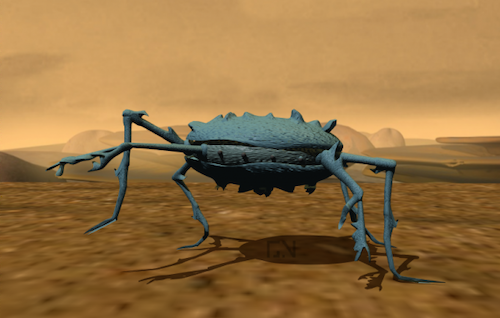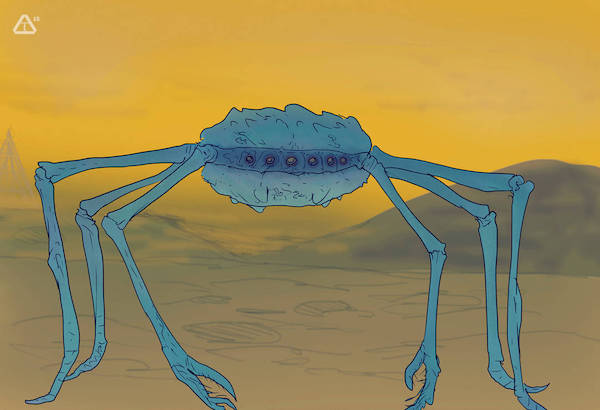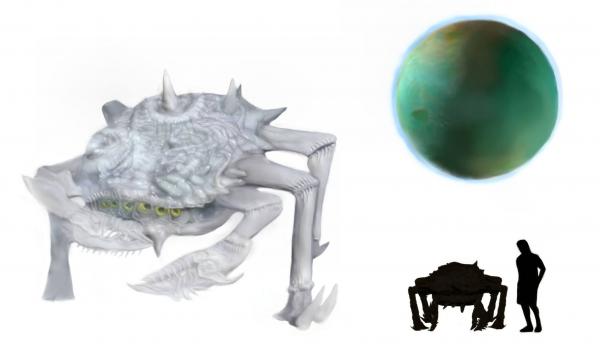BY LETTER
Muuh
The Muuh (a name given to them by an impatient Cygexpa communications officer) apparently evolved on a cold low-gravity Titan-like moon somewhere in the Cygnus direction of the Orion Arm. Their biochemistry is based on liquid hydrocarbons, in a methane-nitrogen atmosphere; it is one of the best known examples of methane-ethane based life.
Life on Muuh worlds, just as on the hypothetical Muuh home world, is based on the production of energy-rich compounds in the upper atmosphere, driven by solar radiation and the magnetic fields of the central planet — contrary to the arrangement on most life bearing worlds, plants are not a significant factor in the local biology. Instead, the primary producers are gatherer animals that collect the nutrients and in turn become prey for other animals. Some gatherers are sedentary, not unlike terrestrial corals or anemones or barnacles, while others are mobile. Various scavengers and saprophytes break down the remains, releasing methane into the atmosphere. The whole pace of life is extremely slow compared to Terragen life.
The Muuh are believed to have evolved from "rapid" mid-sized predator/omnivores; their ancestors would have filled an ecological niche like that of terrestrial raccoons. They are two-meter spider or crab-like creatures with a bark-like spiky exoskeleton that constantly grows (armor-carving is an important part of Muuh appearance and health). There are few external differences between the upper and lower sides; Muuh can simply flip between them with little trouble. Locomotion is through six legs where the front pair branches off a number of manipulator limbs. An ordinary Muuh moves at most one meter per second in a hurry, and most prefer to move much more slowly. Sensory organs, mainly echolocation and a heat sense were located around the rim of the shell. Muuh are hermaphrodites. As a rule they form lifelong pairs which repeatedly bear paired children. These marriage-pairs and sibling-pairs form the central social units of society.
Muuh are very resistant to extremes of cold, and can withstand being frozen solid for long periods of time. However, temperatures above -150 °C are lethal. "Freezing" of course refers to the temperature at which the methane-ethane mix that is their equivalent of water is no longer liquid. Water is a mineral in the Muuh environment, and for the Muuh water ice is a useful solid building material and is often used as part of their spaceships and habs.
 Image from Steve Bowers | |
| Muuh that inhabit low-gravity planets and moons are often lighter in build than those which have colonised heavier worlds. Since their bark-like shell grows continuously, the Muuh trim and carve it into ornamental or symbolic shapes, often humorous. Each member of a pair trims the other's bark, carving messages into their ventral and dorsal surfaces that can be read by touch. | |
Intellectually the Muuh are slow but not stupid thinkers, with excellent long-term memories. If they moved and thought at typical Terragen speeds they would likely be viewed as nearly hyperactive romantics. They are highly imaginative and often prefer fiction and ingenious stories to real life. They devote a great deal of time and effort to creating art, virtual worlds, role-playing scenarios and fantasies in great detail. This has somewhat hampered their technological development, as the strict procedures necessary for science do not appeal to their mindset; instead they tend to prefer inspired experimentation. The reliance on inspiration has made them dependent on their occasional geniuses or correct madmen, who receive further respect and support for their few viable innovations even though 99% of all the ideas they generate don't work out.
Muuh society is variable between different worlds, but tends to be based on inherited status augmented by an elaborate system of advisers/challengers who force the leaders to clarify their decisions. There is a great deal of leeway in how decisions are implemented or obeyed, making their society hard for outsiders to get into. Mutual obligations, gifts and persuasion are important factors in getting anything done.
 Image from Tharsis13 | |
| a muuh on the low gravity world of StoneWaterPalace greets visitors | |
The first Muuh polities encountered by Terragens exist within a volume between Cygnus OB4 and the Cygnus Dark Nebula, and appear to be descended from a single surviving colony ship. The Muuh settlements in this region constitute a local empire around 100 light years across. They were discovered by a Cygexpa probe in 7854 AT, and after 400 years of slow (to humans) initial contact a wormhole link was set up in 8266 to the closest Muuh system (CEA-346746 / Muuhome). It is not known if other Terragens had previously encountered the Muuh, but the possibility of contact by a relativist isolationist ai clade cannot be excluded.
Since the initial discovery many more Muuh colonies have been encountered in a large and sparsely settled volume of space to rimward of the Terragen Sphere; this is presumably the remnant of the old Muuh Empire. A border zone has been established in this region, centered on the Pluton Volume; many cold-loving Terragen clades have migrated there, as well as representatives of the race of Soft Ones known as the Epp. As is well known, the region was devastated during the so-called Epp War, which was the first time that the Muuh revealed their ancient System of Response defenses.
The Muuh do not consider sub-relativistic journeys to be slow, especially since they tend to freeze themselves during the trip and things do not change much between departure and arrival anyway. Their technology is largely cryobiological, based on low-temperature life feeding on Titan-like or Kuiper-belt environments and growing the necessary structures out of polymers, ice and frozen gas.
Muuh and To'ul'hs have some similarities despite their tremendously different biochemistries. Both come from dark worlds where nutrients descend from above, and both employ echolocation and other non-visual senses. This has given them somewhat similar basic view of reality, making it easier for them to understand each other than humans and most other Terragens. It appears the Muuh regard humans and their offspring as yet another hotheaded Inner System species-complex with more energy than style, although some Muuh informants say they have to hand it to the Terragens that they have some useful technology and original perspectives. Trade exchange has been profitable for both groups, although it is clear that the Muuh are not interested in becoming part of any Terragen political organisation, despite some of them having worked closely with the Archailects during the Epp War.
In some ways, the old and sparsely populated Muuh volume is a barrier to further Terragen expansion in the Rimward direction; the Muuh only use a fraction of the resources of the stars in that volume, and negotiations are proceeding to allow Terragen colonists access to some of the unused planets and stars. This initiative has met with limited success to date.
Articles
- Cryovecs, Cryobots - Text by Stephen Inniss, with additions by Steve Bowers
Cold temperature vec phyle. - Cygnus X-1 - Text by Steve Bowers
High mass X-ray binary star system 5984 ly from Sol. - First Contact - Text by Steve Bowers
Strategies and policies for contact with alien life forms (xenobiota) and Xenosophonts (intelligent alien life). - HIE-300-CZE (The Bad Idea) - Text by Steve Bowers
Predatory species provolved by the Muuh; hopefully extinct. - Muuh Architecture - Text by Steve Bowers and Stephen Inniss
The alien xenosophonts known as the Muuh inhabit cold, Titan-like worlds; their architecture is based on living coral-like detritus-feeding organisms. - Muuh Archives - Text by Stephen Inniss
The records of the Muuh as hosted in local Muuh Cyberspace, containing facts and fiction and many things in between. They vary in specific content from settlement to settlement but are universally difficult to interpret. - Muuh Bot - Text by Steve Bowers
Biological robots used by the alien Muuh. - Muuh Cellular Biology - Text by Liam Jones
Nanoscale biomechanics of low-temperature biology in cryosolvents. - Muuh Clade Variation - Text by Stephen Inniss
Muuh diversity is radically lower than that of Terragens, at least among the Muuh encountered so far. The reasons for this are unknown. - Muuh Cyberspaces - Text by Stephen Inniss
Extensive cyberspaces hosted on the processing capabilities of Muuh city-reef-forest architecture. - Muuh Graveyard of Charn - Text by Worldtree
A rediscovered cinder system containing fossilized Muuh mass grave sites and several other mysteries. - Muuh Historifics - Text by Dalex
Unique genre of Muuh art combining characteristics of fiction and factual literature, most often in the form of a virch. - Muuh Iceship - Text by Steve Bowers
An interstellar spacecraft created by the Muuh from an icy object such as a comet. - Muuh Pylons - Text by Dalex
Enigmatic structures created by the Muuh or their automated systems. - Muuh Taboo - Text by Dalex
A catalogue of subjects that the Muuh are reluctant to discuss. - MUUH1 Low Emission Zone Signal - Text by Worldtree, from a concept by Ryan B (Rynn) and Todd Drashner
A mythical, or unverified, series of 14 million year old messages from the Low Emission Zone of the galaxy which hinted at a far larger and more advanced civilization of Muuh. - Muuhformer Minds - Text by Dalex
Automated systems that prepare worlds for colonisation by the Muuh. - Muuhian Epoch - Text by M. Alan Kazlev
Local (Perseus-Outer Orion) historical epoch characterized by the Muuhian interstellar civilization; 1.2 to 0.6 mya. Approximately equivalent in time to the middle Pleistocene of Old Earth. The Muuhian Epoch was followed (after a long period of time) by the Auldlimnerian Epoch. - Muuhome - Text by M. Alan Kazlev
The first Muuh world known to Terragens and the first linked to the Wormhole Nexus. - Pluton Volume, The (and the Epp War) - Text by Steve Bowers and Rakuen07
Wealthy region in the Perseus Arm, with a large xenosophont population; site of the conflict between the Epp and their Methanoid allies, and the Perseus Princes (with the aid of the System of Response). - System of Response - Text by Steve Bowers
Alien AI Defense system. - Tholin Baths - Text by Eric Lo
Spa-like structures built by the Muuh that utilize liquid methane containing the complex organic molecules collectively known as tholins. - Ultima Gate - Text by Dalex
A wormhole of non-terragen origin within boundaries of Muuh space. - Xenobiochemistry - Text by Stephen Inniss
Xenobiochemistry is the study of the comparative biochemistry of Terragen, neogen, and xenobiont organisms. This includes alternatives to water as a solvent, alternative photosynthetic processes (xenophotosynthesis), and many other topics. - Xenosophont Civilisations in the Laniakea Supercluster - Text by ProxCenBound and The Astronomer
Notable alien civilisations in the local galactic supercluster.
Related Topics
Development Notes
Text by Anders Sandberg
additional material by M. Alan Kazlev, Steve Bowers and Stephen Inniss
Initially published on 21 February 2001.
updated as of feb 2022
Muuh downloadable 3d model added February 2025
additional material by M. Alan Kazlev, Steve Bowers and Stephen Inniss
Initially published on 21 February 2001.
updated as of feb 2022
Muuh downloadable 3d model added February 2025
Additional Information
OA Glossary of Terms
Muuh (.obj file) by Steve Bowers DOWNLOAD
Muuh (.obj file) by Steve Bowers DOWNLOAD







